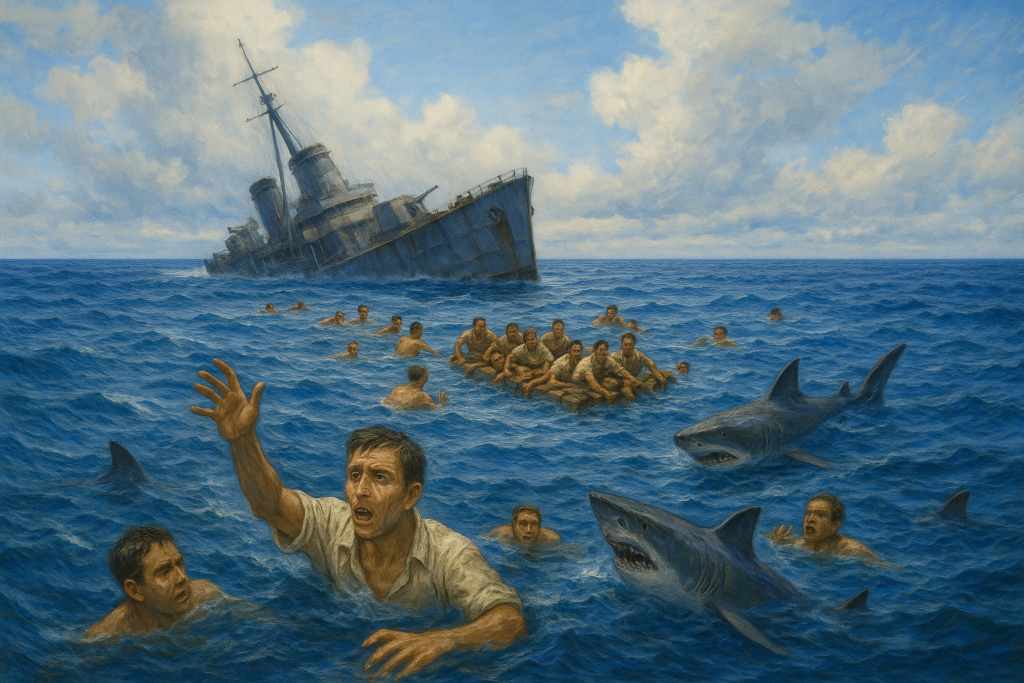
When most people think of shark attacks, they imagine a quick bite near shore or a dramatic movie scene. But the deadliest shark attack in history happened in 1945, when the USS Indianapolis sank during World War II. Around 900 sailors were left stranded in the open ocean, exposed to hunger, dehydration, and relentless sharks. Over four terrifying days, only 316 survived. The story has been warped by rumors, media, and movies over time. The truth is even more haunting than fiction. Here are seven things people often get wrong about the most deadly shark attack ever recorded.
1. It Wasn’t Just Tiger Sharks

Many dramatic retellings point fingers at tiger sharks, but experts suggest oceanic whitetip sharks were the primary predators. These sharks lurk at the surface, can sense vibrations from thrashing sailors, and are known to be persistent in feeding behaviors The roar of frightened survivors drew them in, and once in a feeding frenzy, any movement or blood would have attracted more. That said, tiger sharks likely showed up too, but it was the oceanic whitetips that dominated this tragedy. As one marine biologist explained, they were the first to the carnage, a relentless presence above the doomed sailors, surfacing at night and stalking the survivors in eerie, unyielding waves.
2. Victims Died More from Exposure Than Sharks

Historical accounts confirm that of the 890 men in the water, only 316 were rescued; the vast majority perished from dehydration, “saltwater poisoning” (hypernatremia), sunburn, hypothermia, drowning, and delirium, not shark bites. Sharks often fed on the already-dead or dying, making environmental conditions the primary killers. Survivors described their lips and tongues swelling, foaming at the mouth, and becoming mentally disoriented. Over those four harrowing days, these conditions claimed more lives than shark bites ever could.
3. No One Knew the Ship Was Missing

After the ship sank around 00:15 on July 30, 1945, no distress call had triggered a rescue mission. Operation Commanders assumed a large cruiser like the Indianapolis would check in or appear on schedule so when she didn’t arrive at Leyte Gulf on July 31, no alarm was raised. In fact, radio stations did intercept distress signals, but dismissed them as either errors or potential Japanese trickery. The Navy didn’t realize the ship was overdue until a routine patrol plane spotted survivors nearly four days later. For four agonizing days, no one knew the crew was adrift, and the lack of tracking protocols left nearly 900 men in open water alone, dehydrating and at the mercy of sharks.
4. The Captain Was Blamed, Then Vindicated

Captain Charles B. McVay III was court-martialed in November 1945 for “hazarding his ship” by not zigzagging, despite evidence that zigzagging might not have helped, submarine commander Hashimoto testified it wouldn’t have altered the outcome. The Navy later remitted his sentence and restored his rank, but public opinion and guilt weighed heavily on him. He tragically took his own life in 1968. But a 1999 Senate hearing, sparked by a student’s school project, led to a congressional resolution in October 2000 that officially exonerated him and in 2001, the Navy corrected his record.
5. It Was No Random Journey

The Indianapolis wasn’t on routine patrol; it had just delivered uranium components for the “Little Boy” atomic bomb to Tinian Island, and was sailing alone, unescorted, through enemy-patrolled waters. The mission was so confidential that only two civilian Manhattan Project staffers knew why they were hauling that cargo. This secrecy meant normal routes and safety measures were abandoned. The ship’s solitary transit made it an easy target for submarine ambush and tragedy tied directly to the hidden mission that was shaping history.
6. The Agony of Waiting

Being stranded in open water wasn’t just physically brutal, it was mentally torturous too. Survivors recalled that shark attacks happened mainly at night, when shadows masked the beasts circling below. But it was the unrelenting sun by day and the deep solitude of night that really wore them down. Dehydration, saltwater poisoning, and exposure kicked in, leading to hallucinations, paralysis from thirst, and hopelessness with the real killers slipping in slowly, harder to fight off than any predator.
The documented breakdowns of both mind and body are a chilling reminder that time itself can become an executioner. Sharks may have been the catalysts, but the slow rhythm of despair was the real horror. That haunting wait and that sense of drifting through eternity became the true monster in those shark-infested seas.
7. Jaws Portrays Truth, Not Fiction

The iconic speech in “Jaws”, that bone-chilling recounting of sharks, blood, and emptiness wasn’t Hollywood fantasy. It’s rooted in truth. Quint’s monologue echoes the Indianapolis ordeal: the midnight torpedo, the secret mission delivering bomb components, the silence that followed, the sharks circling, the red water, the blood-curdling screams. Yes, the filmmakers embellished numbers or shifted dates, but the emotional truths, loneliness, terror, desperation were all painfully real. It reminds us this was more than myth, it’s a living memory. What began as part of a blockbuster movie became a haunting tribute to one of the darkest days at sea.
This story 7 Things Everyone Gets Wrong About the Deadliest Shark Attack in History was first published on Daily FETCH


